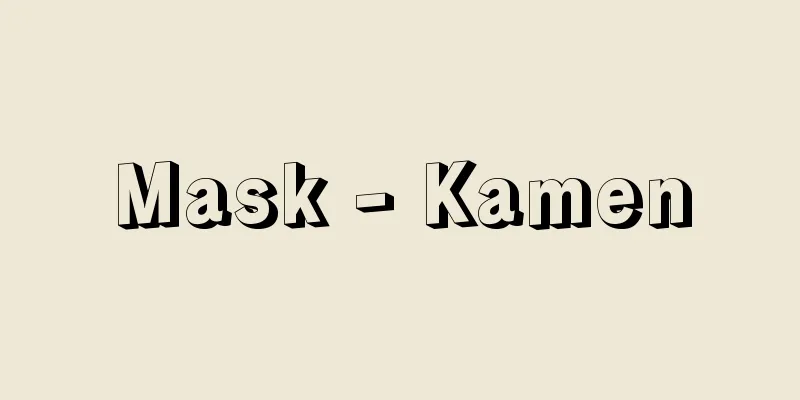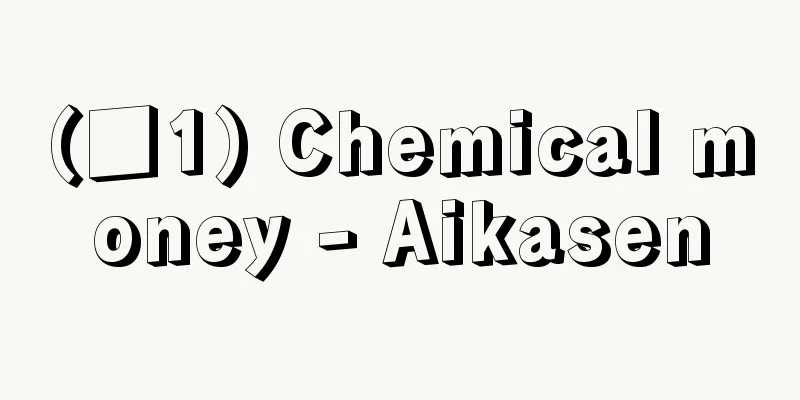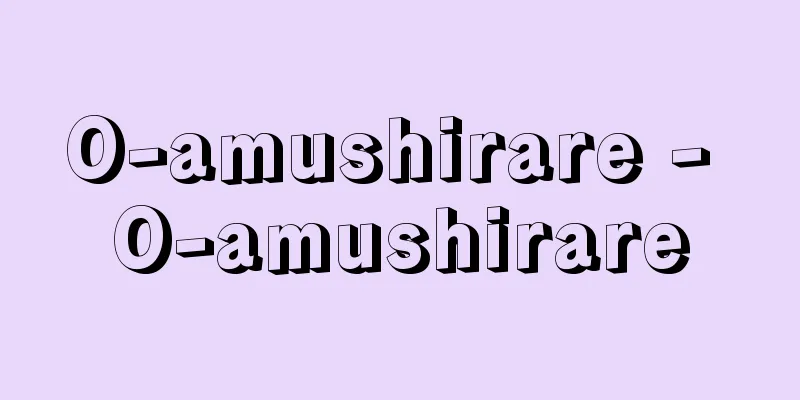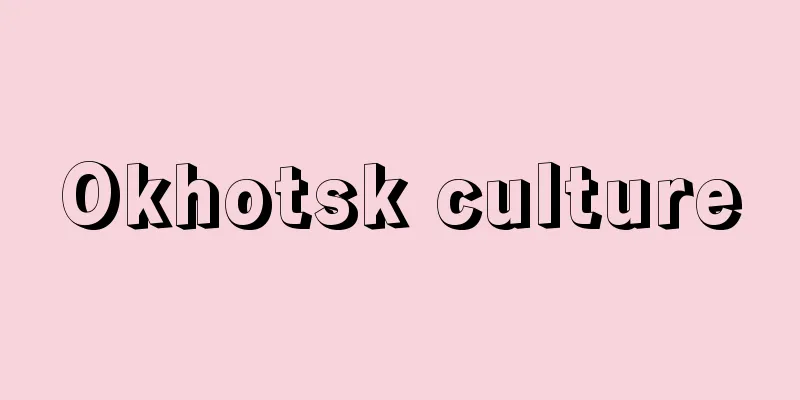Mask - Kamen

|
Originally, the term "mask" meant a mask that was a structure that covered the face for disguise or transformation, but it also refers to a musket that is not worn on the face but is worn on the head, chest, or stomach, a facial sculpture or structure that is not intended to be worn, and a huge mask that covers the whole body. If we interpret the word "mask" as it is, it means a "fake face," that is, a borrowed face that is not the real face, but there are two problems here. (1) Generally speaking, a mask is a sculpture made of wood, metal, paper, clay, animal skin, a combination of shells, woven bast fibers, etc., but the question is whether a face made by applying colored makeup to a human face and adding fangs, horns, bird feathers, etc. to disguise or transform oneself can be called a "mask." Since this is for the purpose of disguise or transformation, it can be included in the category of masks. (2) The question of whether masks for protecting the face, such as kendo masks, fencing masks, or masks for insect, gas, or cold protection, should be called "masks." Since they cover the face and are different from the original face, they have the element of a "mask" in the broad sense, but since they have no purpose of disguise or transformation, they should be excluded in the narrow sense. Some armor (kacchu) has face protection, but in addition to the element of armor, many of these are designed to intimidate the enemy, so they can be said to be somewhere between the broad and narrow definitions mentioned above. Why did humans need "masks"? As can be seen from the cave paintings of Lascaux, which belong to the Paleolithic period, masks have existed since the primitive age of human culture and continue to the present day, and they exist in various ways in various regions of the world. Before discussing the origin and classification of masks, let us consider the original function of masks, which is to satisfy the desire to transform, which is close to human instinct. Humans are physically extremely weak compared to other powerful animals. Furthermore, unlike other animals, we become anxious when we are aware of death, illness, disaster, etc. in advance. We are also not satisfied with our natural state, and we have a personality that cannot do so. In other words, we know that we are anxious and weak beings, but at the same time, we have a strong desire to surpass that self. In order to somehow overcome this essentially contradictory duality, humans used masks. Masks make it possible to change the expression of one's existence just by wearing them. By wearing the mask of a god, ancestor, or monster, humans can feel like they have become those supernatural beings. In addition to these masks of supernatural beings, masks of humans, the dead, animals, etc. are also made, and by combining these, the way the world is can be explained. If humans create such combinations as they wish and perform mimetic magic theatrically, the sacred can reign over evil, and rituals can be performed to bring good fortune and ward off disaster. Therefore, masks play a major role in coming-of-age ceremonies, ancestral worship, hunting and farming fertility rituals, rain-making ceremonies, funerals, and so on. Also, by wearing a mask, a person is both himself and another being other than himself, so an overlap occurs between the self and something other than himself, and the mask enables interaction between the two. Therefore, the "ka" in mask refers to an entity other than the self, and does not mean that the true face of the self takes precedence over the false face. In Noh, masks are called "omote" (face), and in ancient Greek drama, masks are called "persona" (persona), which means that they are the opposite, and that the false face takes precedence over the true face of the person. At least, while wearing the mask, the mask takes precedence over the real face. This is because that is what we wear masks for, and each mask has its own purpose. Taking this a step further, we can create a diagram in which humans wear masks of gods, spirits, monsters, demons, ancestors, or ghosts, and become those beings, and ordinary people regard masked humans as these transcendental beings, so we can say that the mask is a medium through which transcendental beings and humans can spiritually communicate with each other. [Mitsusada Fukasaku] The origin and function of masksThere are various theories about the origin of masks. Masks developed mainly in relation to magical and religious rites and rituals, but as these rites and rituals vary somewhat depending on the region and culture, it is impossible to narrow down their origin to one. The various theories about their origin can be attributed to the diverse functions of masks. Let's look at the broad categories of masks. [Mitsusada Fukasaku] Mask of the DeadEven though the spirits of the dead are immortal, the bodies decay. To prevent decay, mummies are wrapped in cloth. When wrapped in cloth, it becomes difficult to identify the mummy, so masks are placed on the wrapped bodies to identify the person. The golden masks of the kings, royals, and nobles of ancient Egypt, such as King Tutankhamun, and the decorative masks placed on the wrappings of mummies in ancient Andean cultures were for this reason. This is for the sake of both the living and the dead. Since the spirits of the dead are believed to have transcendental powers, the living must hold memorial services for the dead and appease them, and if the spirits of the dead cannot identify the body that is their home, they may harm the living. In ancient Egypt, it was believed that the spirit resided in the heart, but many places around the world believe that the spirit resides in the head. In these places, there is a strong tendency to focus only on the skull. For example, the Munduruku people of the Amazon remove the brain, tongue, eyes, and teeth, patiently dry the skull with the skin still attached over a low fire, and then stuff the eye sockets with resin or wax to create a magnificent face. In New Guinea, the Abma people have a custom of removing only the skull from the grave when the corpse has finished decomposing, molding the skull from clay to resemble the face of the deceased, sprinkling shells on the forehead and eyes, attaching hair, and decorating the face with beautiful patterns, preserving the skull as a precious ancestor of the family. However, the burial masks made of gold, silver, copper, terracotta, and other materials found in Mesopotamia, Phoenicia, and many other parts of the world are placed over the face of the deceased, and are a sign of abandoning attachment to the decaying corpse and of fixing an unchanging image of the deceased on the molded mask. In some regions, it was enough if the mask was made of gold or silver and was symbolic and dignified, but in other places, such as Assyria, it was important that the mask resembled the face of the deceased. In these places, the mask was made directly from the face of the deceased. However, what makes it different from today's death masks is that the mask was made to resemble the face of the deceased, not the face of the deceased, and wearing it allowed the deceased to be considered as a living being. On the other hand, in cultures where spirits that leave the body go to the afterlife to settle there, there is a custom in which the living wear masks with frightening expressions to scare away the dead spirits that are attached to this world and refuse to go to the afterlife, in order to drive them out of the body and send them on their journey to heaven. A typical example of this is the masks of the Dogon people of Africa, who wear masks to scare away the dead and continue to dance for six days during the funeral. [Mitsusada Fukasaku] Coming of Age Ceremony MaskInitiation is a rite of passage when a child who has been protected reaches a certain age and becomes a full-fledged member of the community and takes on the role of protecting the community. In feudal or primitive societies before modern society, becoming a full-fledged member requires being physically, mentally, and physically mature, as well as becoming the kind of person the society requires, and following and supporting the beliefs and customs of that society. Masks play an important role in this rite of passage. That is, the elders wear the masks of intimidating, mysterious, superhuman beings to intimidate the boys attending the coming-of-age ceremony, and make them swear loyalty and obedience to the society. Since coming of age means killing the boy within oneself and being reborn as an adult, in some places the mask of a young spirit is worn during the trial period of the coming-of-age ceremony, and the ceremony to remove the mask is the ceremony for approval of coming of age. In Oceania, Africa, and the Native American world, there are many tribes that form their societies as secret societies, and in these societies, the coming-of-age ceremony has the characteristics of an initiation ceremony that includes religious rites and trial training. Since the initiation into these secret societies places great importance on rules and faith, masks of deities and ancestral spirits are important, and large, diverse, and magnificent masks are used. In particular, Oceanian masks, such as those in New Ireland, New Caledonia, and New Guinea, are dynamically beautiful, using wood carvings, bark coverings, woven bast fibers, and rattan. On the other hand, African masks are uniquely and powerfully carved wood carvings, which are also artistically excellent and have been the subject of worldwide acclaim. [Mitsusada Fukasaku] Masks from fertility and hunting ceremoniesAmong the cultures of the world, there are those that have masks and those that do not. Looking at this from the perspective of hunting, livestock farming, and agriculture, there are almost no masks in livestock farming cultures. This is because livestock themselves are used as sacrifices as a medium to the transcendental world of ancestors and spirits, and there is no particular need for a medium such as a mask. In hunting cultures, there are masks, although not many. It is also true that there is a theory that masks originated from hunting. That is, there is a theory that masks began as masks because primitive people who lived a hunting lifestyle disguised themselves to sneak up on their prey, or that animal masks were used in magical rituals to appease the spirits of animals they had killed and pray for their reproduction and capture. Indeed, such scenes can be seen in cave paintings of primitive art. And, although few in number, hunting masks remain in tribal societies in Africa and other places. Next, masks are used frequently in agricultural cultures. Farming depends more on the weather than on the results of labor. No harvest leads to famine. Therefore, it became important to use magic to manipulate the weather to their advantage, and agricultural rituals became popular, leading to the frequent use of masks. Masks are particularly prevalent among agricultural people in tropical rainy regions. These masks are characterized by a strong animistic flavor. However, the masks themselves are generally simple in terms of materials and manufacturing techniques. [Mitsusada Fukasaku] Totem MaskTotemism is a belief and system that a social group has a special relationship with certain animals, plants, or natural objects. Totemic groups use these animals and plants as symbols of their group and strictly observe taboos related to them. In other words, it is a special form of ancestral worship, telling myths about how distant ancestors became connected to those animals, plants, or natural objects. Most animal totems are snakes, hawks, and leopards, but masks are also essential in religious ceremonies to recreate the connection. These totem masks are carefully kept even outside of festivals, as they are believed to house the totem spirit and have great magical powers. Paintings, sculptures, and totem poles that symbolize totems also have faces painted on them to connect human ancestors to the totem animals and plants. Among these totem masks, those of American Indians are wonderful, combining both animalistic and humanistic, or in other words, human and animalistic faces in one mask. On the other hand, Oceanian totem masks have a bizarre and grotesque power, born from the desire to transcend harsh reality with intense power. In contrast, African totem masks are beautifully carved into long, slender figures of animals such as deer, pumas, and leopards, and have a stylized calm. Many of them are worn on the head like a hat. It is well known that these African masks had a major influence on the founders of modern art, such as Picasso, Matisse, and Braque. Picasso in particular was interested in the bold and naive beauty of African totem masks, and incorporated them into his own work. It is also well known that Klee and Miro were interested in Oceanian masks. [Mitsusada Fukasaku] Shaman MaskShamanism is prominent in Northeast Asia, from Siberia to China, Korea, Japan, and across American Indian culture. In other words, it is a form of religion centered on shamans (magical and religious practitioners) who enter a trance-like abnormal psychological state and directly communicate with gods, spirits, and the dead (they are possessed by gods), and who perform divination, prophecy, healing, and rituals. There are shamans who wear masks and those who do not. Some shamans used to wear masks but do not anymore. For example, Japanese shamans do not wear masks today, but some believe that the "Namahage" festival in Akita is a folk event that left over from the shamanic masks of the past. The most well-known shaman mask that still exists today is that of the Eskimo. Shamans move freely high in the sky and deep underground, interacting with both good and evil spirits, and using the information they obtain to ward off disasters. If the evil spirits were to discover the shaman's face or appearance, there is no telling what kind of retaliation they would receive. This led to the need to disguise themselves. As it is an extremely cold area where no trees grow, many masks are made of animal skins and animal hair, and some are made of animal skins that cover the entire body. The characteristic of the masks is that they have a kind of agility, as if they are moving freely high in the sky or deep underground, even in a mysterious atmosphere. The Kachina masks of the Pueblo Indians of the Americas are also well known. Kachinas are gods such as people who appear in creation myths, animals such as birds, and supernatural beings, and dancers wear masks like hoods when dancing. Wooden carvings of these masks are the famous Kachina dolls. As it is a dry plateau, the shaman's main role is to host rain-making ceremonies for farming, and Kachina masks represent gods such as the spirits of clouds and rain, the sky, the earth, and the stars. [Mitsusada Fukasaku] Masks for exorcising evil spirits and for healing illnessesMisfortunes, including illness, are considered to be the work of evil spirits. For example, illness is considered to be caused by evil spirits entering the human body. Therefore, curing illness means expelling evil spirits from the body. In so-called primitive societies, curing illness and exorcising evil spirits are the same thing. To drive away evil spirits, one must fight them with even greater power. Therefore, it is not uncommon for shamans to wear masks with frightening expressions and pray while beating drums. Among such masks, the Kiphebe masks of the Congo in Africa are excellent in terms of design. Japan is one of the places where exorcisms of various kinds, not just illness, are popular, and there are a wide variety of demon masks used for festivals such as Setsubun to drive away evil spirits and disasters. It is said that simply hanging such masks in the home will bring good fortune and ward off disasters, and they exist as decorative masks all over the world. As described above, masks were considered important in religious and magical rituals in social life and in rites of passage in life, and were used primarily in festivals and ceremonies. [Mitsusada Fukasaku] The Essence of Masks and Their Structural InterpretationBreaking down the word "mask" literally means a disguised mask. In this case, we tend to interpret it as a false face that hides one's true face, that is, a disguised face. However, in the field of philosophy, this contradiction has already been pointed out. In his book "Masks and Personas," philosopher Watsuji Tetsuro explains the history of how the word "persona," which originally meant a mask used in a play, came to refer to a role or character in a play, and then moved beyond the play to mean a role, status, and status in human life. In other words, a mask only has meaning in relation to other actors and audiences in a play, and in relation to other people if we expand its meaning to real life. In other words, humans have their own masks and replace them with other masks depending on their relationship with others. In one situation, they may be a parent, and in another, an employee of a company. There is no human being apart from a role, that is, without a mask. Even if we limit the mask to an aspect of personality, the idea that there is a true face after removing the mask originates from modern European thought, which killed God and believed in the existence of the ego, subject, and identity. However, in rituals of so-called primitive societies, if you remove the physical mask from the face, you will find the face of a living human being, so we should distinguish between masks that can be physically removed and the immaterial masks that can be seen from the way modern people live. The former has been actively discussed in terms of representation, the impression it gives, its artistic value, and ethnographic function. The function of masks has already been described in detail, so here we will touch on the structural interpretation. In his book The Way of the Mask, the French structuralist anthropologist Lévi-Strauss analyzed the ceremonial masks found in both the Salish, the indigenous people living on the northwest coast of North America, and the Kwakiutl, who live to the north. The Salish Swayhwe mask, characterized by a drooping tongue, protruding eyes, and white paint, appears in potlatch ceremonies. Furthermore, this mask is always associated with wealth in the world of myth, and this is also made clear in the rituals. In contrast, the Kwakiutl Kwekwe mask, although it has the same origin and expressive elements from the perspective of the etymology of its name and its design, shows the opposite meaning to wealth in myths and rituals. Rather, the mask associated with wealth is the Zonokwa mask seen in the winter ceremonies of the Kwakiutl, which has sunken eyes, a pursed mouth, and black decorations, and is the polar opposite of the two masks mentioned above. Assuming a south-to-north transmission route, Lévi-Strauss concludes that in the process of a culture's adoption of a mask, if the plastic features are preserved, there is a reversal at the level of meaning, and if the level of meaning is preserved, there is a reversal in the plastic aspects. Unlike analyses that tend to fix the mask and the specific ritual of a specific ethnic group and try to read its message, he always analyzes a mask in a structure of contrast with other masks. This is a method that has already been applied to the analysis of myths and rituals, but the significance of using it in plastic arts to reveal the hidden semantic order that is potentially contained in its form and style, and to approach a more comprehensive cosmological level is great. [Yuji Seki] Masks as toysIn Japan, influenced by Noh masks and Kyogen masks, small masks were made as children's toys and became popular. Toy masks (gangumen) began to be sold during the Edo period, and were made of wood carvings, mainly made from paulownia, cedar, and cypress, as well as paper mache. Masks were given out as religious talismans at festivals and fairs at shrines and temples, and were sold as lucky charms. Mask toys include the Hatsuuma fox mask, which was born from the Inari faith of the time, and mask toys based on Kagura, Kabuki, annual events, and legends. There are a wide variety of types, including Okame, Hyottoko, Oni, Hannya, Tengu, and animals, and from the Meiji period onwards, masks of army and navy personnel and swordplay actors also appeared. Wooden carved masks disappeared during the Taisho period, but papier-mâché masks can still be found throughout the country today as local toys. There are also half-masks made of cardboard called mekazura, which were used at cherry blossom viewing parties and as children's toys. Celluloid masks have been on the market since the Taisho period. Recently, vinyl masks featuring popular TV and manga characters have been seen in the media. [Ryosuke Saito] "The Way of the Mask" by Lévi-Strauss, translated by Yamaguchi Masao et al. (1977, Shinchosha)" ▽ "Thoughts on Masks" edited by Yamashiro Shoji (1982, Libroport)" ▽ "Masks and Personas" by Watsuji Tetsuro (1937, Iwanami Shoten)" ▽ "Hermeneutics of Masks" by Sakabe Megumi (1976, University of Tokyo Press)" ▽ "Masks and Divine Statues of the World" edited by Izumi Yasukazu et al. (1970, Asahi Shimbun) Source: Shogakukan Encyclopedia Nipponica About Encyclopedia Nipponica Information | Legend |
|
本来は、変装・化身のため顔を覆う造形物のマスクmaskをさすが、顔面につけずに頭の上あるいは胸や腹につけるマスケットmasketteや、着用を目的としない顔的彫刻や造形物のマスコイドmaskoidや、全身を覆うような巨大なマスクをも「仮面」とよぶ。仮面を字の示すとおり解釈すれば「仮の面(顔)」、つまり本来の顔ではない借りものの顔のことであるが、ここに二つの問題がある。 (1)一般的には仮面は木、金属、紙、粘土、動物の皮、貝の組合せ、編んだ靭皮(じんぴ)繊維などでつくられた造形物のことであるが、人間の顔面に色彩を塗り付けメーキャップし、牙(きば)や角(つの)や鳥の羽などをつけて変装・化身した顔を「仮面」とよんでよいかの問題。これは変装・化身を目的としているので、仮面に含めてよい。 (2)剣道の面やフェンシングのマスク、あるいは防虫・防毒・防寒用のマスクのように、顔面を保護するためのマスクを「仮面」とよんでよいかの問題。顔を覆うことにより本来の顔とは違ってくるので広義では「仮面」の要素があるが、変装・化身の目的がないので狭義では除外すべきであろう。甲冑(かっちゅう)には顔面保護の防具をつけたものがあるが、これには防具の要素とともに敵を威嚇するデザインも少なくないので、これらは前述の広義と狭義の中間的存在といえよう。 人類はなぜ「仮の面」(仮面)を必要としたか。仮面は、旧石器時代に属するラスコーの洞窟(どうくつ)壁画をみてもわかるように、人類文化の原始時代から存在し現在に至っているし、地球上の各地域に多様に存在している。仮面の起源や分類を述べる前に、仮面のもつ本来の機能を考察すると、それは人類の本能に近い変身願望を満たすものである。人類は強大な他の動物に比較すると、肉体的にきわめて非力である。そのうえ、他の動物と違って、死、病気、災禍などを事前に意識して不安になる。また、ありのままの姿ではとうてい満足しないし、できない性格をもつ。いいかえれば、不安で弱い存在の自分を知るとともに、一方そうした自己を超えたいという欲求を強烈にもっている。こうした本質的に矛盾した二重性をなんとか克服するため、人類は仮面を用いた。仮面は、かぶることだけで存在自体の表情を変えることを可能にする。神や祖霊や妖怪(ようかい)などの仮面をかぶれば、人類はそれら超自然的存在になった気になれる。こうした超自然的存在の仮面のほかに、人間や死者や動物などの仮面もつくり、それらを組み合わせれば、この世のあり方も説明できる。その組合せを人類が思い望むようにつくり、模倣呪術(じゅじゅつ)を演劇的に行えば、聖なるものが凶なるものの上に君臨し、招福除災の儀式ができる。したがって、成人式、祖霊祭祀(さいし)、狩猟農耕の豊饒(ほうじょう)の儀式、雨乞(あまご)い、葬祭などに、仮面の果たす役割は大きい。また、仮面をかぶることにより、人は自己であると同時に自分以外の別の存在ともなるので、自己と自己以外のものとの重複がおこり、両者の交流が仮面によって可能になる。 したがって、仮面の「仮」とは、自己以外の存在のことであり、本来の自己の顔が仮の顔より優先するということではない。能で仮面を「おもて」とよび、古代ギリシア劇で仮面を「ペルソナ」とよぶのは、むしろその反対で、仮の面を人間本来の顔よりも優先させている名称といえよう。少なくとも、仮面をつけている間は、仮面は実際の顔よりも優先される。なぜなら、そのために仮面をつけるのであり、仮面には使用の目的がそれぞれあるからである。さらにこれを一歩進めて考えれば、人間がたとえば神や精霊や妖怪悪魔や祖霊や死霊などの仮面をつけ、それらの存在となり、一般の人々が仮面をつけた人間をそれらの超越的な存在とみなすという図式ができるので、仮面は超越的存在と人間とが霊的に交流する媒体となるもの、といえよう。 [深作光貞] 仮面の起源とその機能仮面の起源にはいろいろな説がある。仮面は主として呪術的宗教的儀礼や祭祀を中心に発達したが、そうした儀礼や祭祀は地域や文化によって多少とも異なるため、起源も一つに絞ることは不可能で、起源説がさまざまなことは仮面の機能の多様さのためであるといえる。大別してどのような仮面があるかをみてみよう。 [深作光貞] 死霊の仮面死者の霊は不滅としても、遺体は腐る。腐らないようにミイラにするには布巻きをする。布巻きをすると、だれのミイラかわからなくなるので、布巻き遺体に仮面をつけ、だれの遺体かを明らかにする。ツタンカーメン王で有名な古代エジプトの王や王族・貴族の黄金の仮面や、古代アンデス文化のミイラの包みの上に置く飾り首の仮面も、このような必要からである。これは生者のためでもあり、死者のためでもある。死霊は超越的能力をもつものとされているので、生者は死者を供養し鎮魂しなければならないし、死霊は自分のすみかである遺体がわからなくなると生者に危害を加えかねないからである。古代エジプトでは霊は心臓に宿ると考えられていたが、世界では霊は頭に宿るとする所が多い。こうした所では、頭蓋(ずがい)骨のみを関心の対象とする傾向が強い。たとえば、アマゾンのムンドゥルク人は、脳や舌や目や歯を取り除き、とろ火で気長に表皮のついた頭蓋骨を乾燥させ、眼窩(がんか)に樹脂や蝋(ろう)を詰め込み、みごとな顔づくりをした。ニューギニアには、遺体が腐り終わったころ墓から頭蓋骨だけを取り出し、粘土で生前の顔に造形し、額や目に貝をちりばめ、毛髪をつけ美しい文様を顔面に施し、一家一族のだいじな祖霊として保存するアブマ人などの風習がある。しかし、メソポタミア、フェニキアをはじめ世界の多くの地で発見される金、銀、銅、テラコッタなどの埋葬用仮面は、死者の顔にかぶせたもので、腐りゆく遺体に対する執着を捨て、造形物の仮面に故人の不変のおもかげを定着させたものである。その仮面が金銀などの材料で威厳のあるシンボリックなものであれば満足した地方もあるが、たとえばアッシリアのように、生前の顔と似ていることを重視した所もある。こうした所では直接に死者の顔から型をとった。ただし、今日でいうデスマスクと違うところは、これを死者の顔でなく生前の顔に仕立て、これをかぶることで死者を生きている存在とみなしていた点である。 他方、遺体を離れた霊はあの世に行って定住するものとする文化では、この世に執着してなかなかあの世に行こうとしない死霊を遺体から追い出し天界に旅立たせるため、生者たちが恐ろしい形相の仮面をかぶり死霊を脅す風習がある。その代表的なものがアフリカのドゴン人の仮面で、人々は葬儀の間の6日間、死霊を恐れさせるための仮面をつけて、追い出しの踊りを踊り続ける。 [深作光貞] 成人式仮面いままで保護されてきた子供が一定の年齢に達し、これからは共同体の一人前の成員となり共同体を保護する立場に変わる通過儀礼が成人式initiationである。近代社会以前の封建社会あるいは未開社会において、一人前の成員となることは、肉体的、精神的、能力的に一人前であることと同時に、その社会の求める人間となり、その社会の信仰やしきたりに従い、それらを支える者でなければならない。その通過儀礼で、仮面は重要な役割を担う。すなわち、長老たちは威圧的な怪奇な超人間的存在の仮面をかぶり、成年の儀式の少年たちに恐怖を与え、社会への忠誠と服従を誓わせる。成人とは、自分のなかの少年を殺し、大人として生まれ変わることであるから、成人式の試練期間中は幼い精霊の仮面をつけていて、その仮面を取り除く儀式が成人認可の式とする所もある。オセアニアでもアフリカでもアメリカ先住民の世界でも、その社会結成を秘密結社組織にしている部族が少なくなく、そうした社会での成人式は、宗教儀礼と試練訓練を内容とする入門式の性格をもつ。こうした秘密結社の入門には掟(おきて)や信仰が重視されるので、神像的仮面や祖霊の仮面がだいじで、大形の多様でみごとな仮面が用いられる。とくにニュー・アイルランド、ニュー・カレドニア、ニューギニアなどのオセアニアの仮面は、木彫りのほか樹皮張りや編んだ靭皮繊維や籐(とう)などを駆使してダイナミックな美しさを示している。一方、アフリカの仮面は、独特の力強い造形の木彫りで、これまた美術的に優れていて、世界的賞賛の的となっている。 [深作光貞] 豊猟・豊饒儀礼の仮面世界の諸文化には、仮面のある文化とない文化とがある。これを狩猟、牧畜、農耕の次元から眺めると、牧畜文化には仮面はほとんどない。それは、祖霊、神霊などの超越世界との媒体としての供犠(くぎ)に、家畜そのものが使われるので、とくに仮面という媒体を必要としなかったためであろう。狩猟文化には、あまり多くはないが仮面が存在している。仮面の起源説に狩猟起源説があることも事実である。すなわち、狩猟生活を営む原始人たちは擬装して獲物に忍び寄ったので、その擬装が仮面の始まりになったという説、あるいは、殺した獣の霊を慰め、その繁殖と捕獲を祈る呪術儀礼に動物の仮面を用いたという説もある。確かに原始美術の洞窟画にそのような光景がみられる。そして、数は少ないがアフリカなどの部族社会に狩猟仮面が存続している。次に、農耕文化では仮面をしきりに用いる。農耕は、労働の成果以上に天候に左右される。収穫がなければ飢餓につながる。そこで呪術によって天候を自分たちに有利に操作することが重要となり、農耕儀礼が盛んになり、仮面がしきりに使用されたわけである。そのなかでも熱帯多雨地域の農耕民にとくに仮面が多い。その仮面にはアニミズム色が強いことが特徴である。ただし、一般的に仮面そのものは、材料的にも作製技術的にも素朴なものが多い。 [深作光貞] トーテム仮面トーテミズムとは、ある社会集団が特定の動植物あるいは自然物などとなんらかの特殊な関係にあるとする信仰およびその制度のことである。トーテム集団ではそれらの動植物を自分たちの集団の象徴として占有し、それに関するタブーを厳しく守る。いいかえれば、祖霊信仰のある特殊な形態であり、遠い先祖がどのようにしてその動植物や自然物と結び付いたかを神話で物語っている。動物のトーテムには、ヘビ、タカ、ヒョウが多いが、宗教儀礼でもその結び付きを再現するために仮面が不可欠になる。こうしたトーテムの仮面は、祭り以外のときでもトーテムの霊が宿り強大な呪力をもったものとして、たいせつに保管される。トーテムを象徴する絵画や彫刻あるいはトーテムポールも、人間の祖先とトーテム動植物を結び付けるため顔面が描かれる。こうしたトーテム仮面ではアメリカ・インディアンのものがすばらしく、動物的であって人間的、いわば人間と動物の顔が一つの仮面に組み合わされている。一方、オセアニアのトーテム仮面には、厳しい現実を激しい力で超越したい願望から、奇怪でグロテスクな迫力がある。その点、アフリカのトーテム仮面は、シカ、ピューマ、ヒョウなどを細長く美しく彫っていて様式化された落ち着きをもつ。形も帽子のように頭からかぶる仮面が多い。こうしたアフリカの仮面が、近代美術の創始者たちピカソやマチスやブラックたちに影響を大きく与えていることは承知のとおりである。とくにピカソは、アフリカのトーテム仮面の大胆でナイーブな美しさをもつ造形に興味をもち、自分の制作に取り入れたといえよう。一方クレーやミロは、オセアニアのものに興味を示したことも、よく知られていることである。 [深作光貞] シャーマンの仮面シベリアから中国、朝鮮、日本などアジア北東部を中心に、アメリカ・インディアン文化にわたって、シャーマニズムが顕著にみられる。すなわち、トランスのような異常心理状態になって、神や精霊や死霊と直接交流し(神がのりうつる)、占い、予言、治病、祭儀などを行うシャーマン(呪術的宗教的職能者)を中心とする宗教形態である。シャーマニズムには、シャーマンが仮面を用いるものと用いないものとがある。かつては用いたが、いまは用いないものもある。たとえば、日本のシャーマンは現在仮面を用いないが、秋田の祭りの「なまはげ」は、かつてのシャーマン的仮面が民俗行事として残ったものではないか、とみなす者もいる。現存するシャーマンの仮面で、もっとも知られているのはエスキモーのそれである。シャーマンは天高く地下深く自由に行動し、善霊にも悪霊にも接し、得た情報で人々の除災を図る。このときシャーマンが顔や姿を悪霊に知られたら、どんな仕返しを受けるかわからない。そこで変装する必要がおこった。樹木も生えない極寒地なので、仮面は獣皮に獣毛を配したものが多く、全身すっぽり覆う獣皮製のものもある。仮面の特徴は、神秘的な雰囲気のなかにも、天高く地下深く自由に行動するような一種の身軽さをもっていることであろう。アメリカ大陸のプエブロ・インディアンのカチナ仮面もよく知られている。カチナとは、創世神話に登場する人物、鳥などの動物、超自然的存在などの神々のことで、踊り手たちは仮面を頭巾(ずきん)のようにすっぽりかぶって踊る。その木彫りが有名なカチナ人形である。乾燥した高原なので、シャーマンの最大の役割は農耕の雨乞いの儀式の主催であり、カチナ仮面も雲や雨の霊、空、大地、星などの神々を表している。 [深作光貞] 悪霊払いや治病用仮面病気をはじめとする災禍は、悪霊の仕業と考える。たとえば病気は悪霊が人体に侵入したことによっておこるものとみなす。したがって、病気を治すこととは人体から悪霊を追い出すことになる。いわゆる未開社会では、治病と悪霊払いは同一のものである。悪霊を追い払うには、それ以上の力で対抗しなければならない。したがって、シャーマンが恐ろしい形相の仮面をつけ、太鼓など打ち鳴らして祈祷(きとう)する風習が珍しくない。こうした仮面ではアフリカのコンゴのキフェベ仮面が造形的に優れている。病気ばかりでなく種々の厄払いの盛んな所の一つが日本で、節分をはじめとして悪鬼・災禍を払う祭り用の鬼などの面が多彩にある。こうした仮面は、家に掛けておくだけで招福除災になるとされ、飾り仮面として世界のあちこちに存在する。 以上のように、仮面は社会生活の宗教的・呪術的儀礼、人生の通過儀礼で重要視され、祭祀や行事を中心として使用された。 [深作光貞] 仮面の本質と構造論的解釈仮面という語を分解すると、文字どおり仮の面となる。この場合、われわれは本当の顔、すなわち素顔を隠蔽(いんぺい)したにせの顔、変装した顔という解釈をしがちである。しかし哲学の分野では、この矛盾がすでに指摘されている。哲学者、和辻哲郎(わつじてつろう)は、その著書『面とペルソナ』のなかで、劇に用いられる面を意味した「ペルソナ」の語が、劇中における役割、人物を示すようになり、さらに劇から離れて人間生活における役割、地位、身分などにまで意味を転じるようになる歴史を説明している。つまり仮面は、一方で劇中の他の役者や観客との関係のなかで、他方、現実生活に意味を広げれば、他の人々とのかかわりにおいて初めて意味をもつものなのである。いいかえれば、人間は、他者とのかかわりあいに応じて、自分の仮面をもち、別の仮面と取り替えるのである。ある場面では子供の親であったり、別の場面では会社の社員であったりするわけである。役割を離れた、すなわち仮面をもたない人間の存在はない。仮面を人格の面に限定したとしても、仮面を取り去ったあとに素顔があるという考え方は、神を殺し、自我とか主体、アイデンティティの存在を信じたヨーロッパ近代思想に由来するものである。 しかし、いわゆる未開社会をはじめとする儀礼で、実際に仮面という物体を顔から取り去れば、そこには生きた人間の顔があるわけで、やはり物理的に取り外しのきく仮面と、現代人の生き方から読み取れる、いわば非物質的な仮面とは区別して論じるべきであろう。 前者については、これまで表現描写、それがもたらす印象、美術的価値、民族誌的機能論も加えて盛んに論じられてきている。仮面のもつ機能についてはすでに詳しく述べられているので、ここでは構造論的解釈に触れておこう。構造主義人類学者と称されるフランスのレビ(レヴィ)・ストロースは、その著書『仮面の道』のなかで、北アメリカ北西海岸に住む先住民であるサリシュと、彼らの北に住むクワキウトルの双方にみられる儀礼用仮面を分析している。サリシュのスワイフウェ仮面は、垂れ下がった舌と突き出た目、白色系の塗彩を特徴にもち、ポトラッチ儀礼で登場する。さらにこの仮面は、神話の世界でつねに富と結び付き、儀礼でもその点が明らかにされる。これに対し、クワキウトルのクウェクウェ仮面は、その名の語源、あるいは造形的観点からみて、同一の起源と表現要素を備えているにもかかわらず、神話や儀礼から読み取れる意味は、富とは正反対の内容を示している。むしろ富と結び付くのは、クワキウトルの冬の儀礼でみられるゾノクワ仮面であって、これはくぼんだ目、すぼめた口、黒色系の装飾をもち、前述の二つの仮面とは造形上対極に位置している。南から北への伝播(でんぱ)経路を想定するレビ・ストロースは、文化が仮面を受容する過程で、造形的特徴が保持される場合は、意味のレベルで逆転がみられ、意味のレベルが保持されれば、造形面での逆転がおこるという結論に達している。仮面と特定の民族の特定の儀礼という場に固定して、そのメッセージを読み取ろうとしがちな分析とは異なり、一つの仮面をつねに他の仮面との対比関係構造内に置いて分析している。これは、神話や儀礼の分析ですでに適用されている手法ではあるが、造形芸術に用い、その形や様式が潜在的にもつ隠れた意味論的秩序を明らかにし、さらにより包括的な宇宙論的レベルにまで迫ろうとした意義は大きい。 [関 雄二] 玩具としての仮面日本では能面、狂言面などの影響を受けて、子供の遊び道具として小形の面が製作され、流行するようになった。玩具面(がんぐめん)が売り出されるようになったのは江戸時代からで、材料には主としてキリ、スギ、ヒノキなどを用いた木彫りのものと、紙の張り子製とがあった。神社寺院の祭礼、縁日などで信仰的な護符(ごふ)として面が授与され、縁起物として売られた。当時の稲荷(いなり)信仰から生まれた初午(はつうま)の狐面(きつねめん)や、神楽(かぐら)、歌舞伎(かぶき)、年中行事、伝説を面玩具化したものなどがある。種類も、おかめ、ひょっとこ、鬼、般若(はんにゃ)、天狗(てんぐ)、動物類と多種多様で、明治期以降は陸海軍人や剣劇俳優などの面が出現した時期もある。木彫り面は大正期から姿を消したが、張り子面は現在も郷土玩具として全国各地にある。厚紙製の目鬘(めかずら)という半面型のものもあり、花見などに用いられ、子供の遊び道具にされた。セルロイド製が大正期から出回った。最近はテレビや漫画の人気者を扱ったマスコミもののビニル製のものがみられる。 [斎藤良輔] 『レヴィ・ストロース著、山口昌男他訳『仮面の道』(1977・新潮社)』▽『山城祥二編『仮面考』(1982・リブロポート)』▽『和辻哲郎著『面とペルソナ』(1937・岩波書店)』▽『坂部恵著『仮面の解釈学』(1976・東京大学出版会)』▽『泉靖一他編『世界の仮面と神像』(1970・朝日新聞社)』 出典 小学館 日本大百科全書(ニッポニカ)日本大百科全書(ニッポニカ)について 情報 | 凡例 |
Recommend
Siberian iris
…(3) Biedres irises (those without hair-like proj...
Plotosus anguillaris (English spelling)
A marine fish of the family Scyllidae in the order...
Guiyang Prefecture
…In Pingba, a group of Song-dynasty tombs of ethn...
Esen - Esen (English spelling)
He was the leader of the Choros tribe of the Oira...
Imperial command - Rinji
Documents issued by Kurodo (Treasury Secretary) a...
Carburetor - Carburetor
A device that supplies a suitable mixture of air ...
Relief order - Relief order
An order is issued by the Labor Relations Commissi...
special visual effects
…Special photographic effects (or special visual ...
Identitätsphilosophie (English spelling)
…In his System of Transcendental Idealism (1801),...
umara (English spelling)
…In the original system, all those who served the...
Arzú Irigoyen, Alvaro
Born March 14, 1946 in Guatemala City. Guatemalan ...
Ledra
…The outer port of Famagusta is 53 km to the east...
Tsukinukisou (English name) Triosteum sinuatum Maxim.
A perennial herb of the Caprifoliaceae family that...
Soft component
...Low-energy protons and neutrons are also relea...
Acoustotaxis - Acoustotaxis
…For example, moths and other insects fly toward ...









